
Star formation is the process by which dense regions within molecular clouds in interstellar space, sometimes referred to as "stellar nurseries" or "star-forming regions", collapse and form stars. As a branch of astronomy, star formation includes the study of the interstellar medium (ISM) and giant molecular clouds (GMC) as precursors to the star formation process, and the study of protostars and young stellar objects as its immediate products. It is closely related to planet formation, another branch of astronomy. Star formation theory, as well as accounting for the formation of a single star, must also account for the statistics of binary stars and the initial mass function. Most stars do not form in isolation but as part of a group of stars referred as star clusters or stellar associations.

The nebular hypothesis is the most widely accepted model in the field of cosmogony to explain the formation and evolution of the Solar System. It suggests the Solar System is formed from gas and dust orbiting the Sun which clumped up together to form the planets. The theory was developed by Immanuel Kant and published in his Universal Natural History and Theory of the Heavens (1755) and then modified in 1796 by Pierre Laplace. Originally applied to the Solar System, the process of planetary system formation is now thought to be at work throughout the universe. The widely accepted modern variant of the nebular theory is the solar nebular disk model (SNDM) or solar nebular model. It offered explanations for a variety of properties of the Solar System, including the nearly circular and coplanar orbits of the planets, and their motion in the same direction as the Sun's rotation. Some elements of the original nebular theory are echoed in modern theories of planetary formation, but most elements have been superseded.

A proplyd, short for ionized protoplanetary disk, is an externally illuminated photoevaporating protoplanetary disk around a young star. Nearly 180 proplyds have been discovered in the Orion Nebula. Images of proplyds in other star-forming regions are rare, while Orion is the only region with a large known sample due to its relative proximity to Earth.

T Tauri is a trinary variable star in the constellation Taurus, the prototype of the T Tauri stars. It was discovered in October 1852 by John Russell Hind. T Tauri appears from Earth amongst the Hyades cluster, not far from ε Tauri, but it is actually 420 light-years behind it and not a member of the cluster. The cloud to the west of the system is NGC 1555, known more commonly as Hind's Variable Nebula.

Herbig–Haro (HH) objects are bright patches of nebulosity associated with newborn stars. They are formed when narrow jets of partially ionised gas ejected by stars collide with nearby clouds of gas and dust at several hundred kilometers per second. Herbig–Haro objects are commonly found in star-forming regions, and several are often seen around a single star, aligned with its rotational axis. Most of them lie within about one parsec of the source, although some have been observed several parsecs away. HH objects are transient phenomena that last around a few tens of thousands of years. They can change visibly over timescales of a few years as they move rapidly away from their parent star into the gas clouds of interstellar space. Hubble Space Telescope observations have revealed the complex evolution of HH objects over the period of a few years, as parts of the nebula fade while others brighten as they collide with the clumpy material of the interstellar medium.

A bipolar outflow comprises two continuous flows of gas from the poles of a star. Bipolar outflows may be associated with protostars, or with evolved post-AGB stars.

HH 46/47 is a complex of Herbig–Haro objects, located around 450 parsecs away in a Bok globule near the Gum nebula. Jets of partially ionized gas emerging from a young star produce visible shocks upon impact with the ambient medium. Discovered in 1977, it is one of the most studied HH objects and the first jet to be associated with young stars was found in HH 46/47. Four emission nebulae, HH 46, HH 47A, HH 47C and HH 47D and a jet, HH 47B, have been identified in the complex. It also contains a mostly unipolar molecular outflow, and two large bow shocks on opposite sides of the source star. The overall size of the complex is about 3 parsecs.

The Becklin–Neugebauer Object(BN) is an object visible only in the infrared in the Orion molecular cloud 1 (OMC1). It was discovered in 1967 by Eric Becklin and Gerry Neugebauer during their near-infrared survey of the Orion Nebula. A faint glow around the center-most stars can be observed in the visible light spectrum, especially with the aid of a telescope.
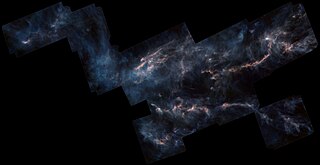
The Taurus molecular cloud (TMC-1) is an interstellar molecular cloud in the constellations Taurus and Auriga. This cloud hosts a stellar nursery containing hundreds of newly formed stars. The Taurus molecular cloud is only 140 pc away from Earth, making it possibly the nearest large star formation region. It has been important in star formation studies at all wavelengths.
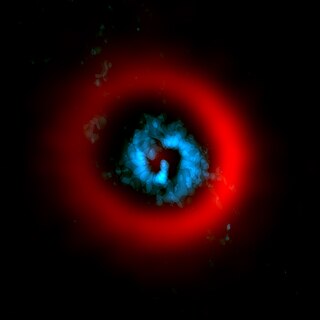
AB Aurigae is a young Herbig Ae star in the Auriga constellation. It is located at a distance of approximately 531 light years from the Sun based on stellar parallax. This pre-main-sequence star has a stellar classification of A0Ve, matching an A-type main-sequence star with emission lines in the spectrum. It has 2.4 times the mass of the Sun and is radiating 38 times the Sun's luminosity from its photosphere at an effective temperature of 9,772 K. The radio emission from the system suggests the presence of a thermal jet originating from the star with a velocity of 300 km s−1. This is causing an estimated mass loss of 1.7×10−8 M☉ yr−1.
Scott Jay Kenyon is an American astrophysicist. His work has included advances in symbiotic and other types of interacting binary stars, the formation and evolution of stars, and the formation of planetary systems.

HL Tauri is a young T Tauri star in the constellation Taurus, approximately 450 light-years (140 pc) from Earth in the Taurus Molecular Cloud. The luminosity and effective temperature of HL Tauri imply that its age is less than 100,000 years. At apparent magnitude 15.1, it is too faint to be seen with the unaided eye. It is surrounded by a protoplanetary disk marked by dark bands visible in submillimeter radiation that may indicate a number of planets in the process of formation. It is accompanied by the Herbig–Haro object HH 150, a jet of gas emitted along the rotational axis of the disk that is colliding with nearby interstellar dust and gas.

Westerhout 40 or W40 is a star-forming region in the Milky Way located in the constellation Serpens. In this region, interstellar gas forming a diffuse nebula surrounds a cluster of several hundred new-born stars. The distance to W40 is 436 ± 9 pc, making it one of the closest sites of formation of high-mass O-type and B-type stars. The ionizing radiation from the massive OB stars has created an H II region, which has an hour-glass morphology.
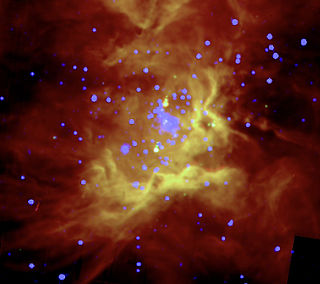
RCW 36 is an emission nebula containing an open cluster in the constellation Vela. This H II region is part of a larger-scale star-forming complex known as the Vela Molecular Ridge (VMR), a collection of molecular clouds in the Milky Way that contain multiple sites of ongoing star-formation activity. The VMR is made up of several distinct clouds, and RCW 36 is embedded in the VMR Cloud C.

L1551 IRS 5 is a protostellar envelope surrounding a binary protostar system in the constellation of Taurus 450 light-years from Earth. The binary system itself is known as L1551 NE, and each star is surrounded by protoplanetary disk. The system is one of Jim Kaler's The 100 greatest stars.
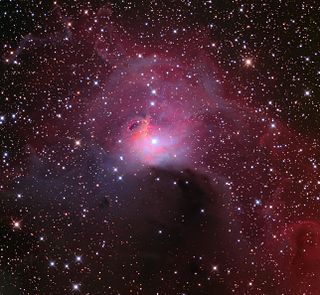
Sh 2-297 is an emission nebula in the constellation Canis Major. The region was catalogued in 1959 in the extended seconded edition of the Sharpless catalogue. This area is part of the Canis Major OB1 Association, and is a very active area of new star formation.
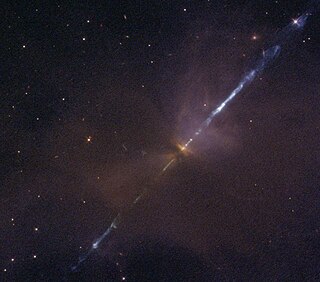
HH 111 is a Herbig-Haro object in the L1617 dark cloud of the Orion B molecular cloud in the constellation of Orion. It is a prototype of a highly collimated optical jet sources. It shows several bow shocks and has a length of about 2.6 light-years.

GK Tauri is a young binary system composed of T Tauri-type pre-main sequence stars in the constellation of Taurus about 466 light years away, belonging to the Taurus Molecular Cloud.

DL Tauri is a young T Tauri-type pre-main sequence stars in the constellation of Taurus about 522 light years away, belonging to the Taurus Molecular Cloud. It is partially obscured by the foreground gas cloud rich in carbon monoxide, and is still accreting mass, producing 0.14 L☉ due to release of accretion energy. The stellar spectrum shows the lines of ionized oxygen, nitrogen, sulfur and iron.



















